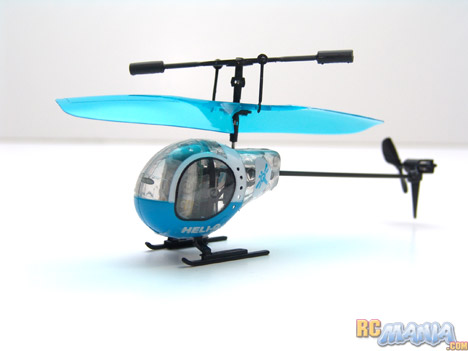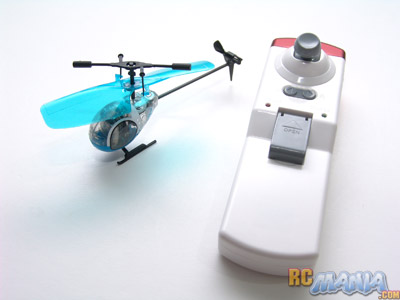Heli-Q

Street Price: $39.99 US
Manufacturer: Takara-Tomy
Mfgr's recommended min. age: n/a
Our recommended age range: 10+
Primary use: Indoor
Radio: n/a - infrared
Includes:
- Assembled heli
- Transmitter/charger
- Manual
- 6x AA batteries
Initial Impressions
I was really shocked when the Silverlit Picco-Z (later sold as the Air Hogs Havoc) first came out and proved that it could actually fly, even though it fit in the space of an adult hand. Everything that could be done to minimize the size and weight was packed into one unbelievably tiny RC heli that actually worked. Then, one day browsing around eBay, I found the Heli-Q. It's noticeably smaller and lighter than even the Havoc! From the front of the fuselage to the tip of the tail is less than 5". I kid you not.
 |
Unlike the Havoc, the Heli-Q uses a hard plastic shell for the fuselage that is actually transparent so you can see through it. The tail is the tiniest square tube of high-tech carbon fiber (the stuff spacecraft , fighter jets, and formula one cars are made with). The main rotor blades are translucent, too, and available in different colors that indicate what channel the heli runs on.
The controller/charger, seen above, is a bizarre one-handed device that looks like it was a Nintendo Wiimote prototype. You hold it like a TV remote (or a Wiimote!) and operate the spring-loaded joystick with your thumb. Sounds a little tricky, but we'll see how it goes.
Preparing to fly
The remote takes 6 AA batteries and, like with many ultra-micro RC sets, it doubles as the charger. A door on the front opens to reveal a short charging cord that you plug directly into the bottom of the heli itself. Full charging takes 5-10 minutes, then you're ready to go.
Testing
What I immediately noticed when I got ready to fly the Heli-Q for the first time was that a one-handed controller makes a lot of sense. It hets you conveniently hold the heli with one hand, and have the controller in the other for full maneuverability right from launch. I launched, and quickly went into a spiral. I adjusted the trim on the controller (also accessible with the same thumb) and tried again until I could get it flying somewhat "stable." I use the term "stable" very loosely because the diminutive Heli-Q felt like it was constantly on the edge of going out of control, and indeed, within about 10 seconds on every flight, it would manage to hit a wall or crash land on the ground.
The single joystick for both throttle and directional control is difficult to get used to, but the real key is being very patient and making small movements. It's very twitchy! The heli had a tendency to move backwards on its own, so I put some folds of tape on the nose to help balance it better. Still, my very longest flight was less than 20 seconds, and that was fluttering all around an 11-foot square room. Most flights were just 5 to 7 seconds!
Conclusion
This is a cool-looking high-tech ultra-micro concept from the innovative minds of Japan, but sadly, it just doesn't work well at all. Novel concept, novel looks, novel controller, not a fun toy. I'm an experienced RC Maniac and have flown many helis, and if it takes all of my skill to keep the Heli-Q flying for more than 7 seconds, I can't recommend it to anyone.





